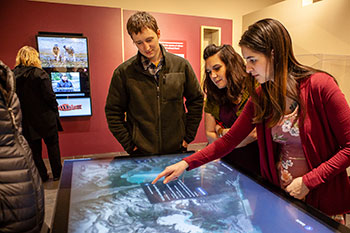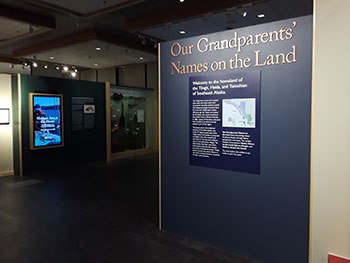Grant Spotlight | October 29, 2020
Share ThisOctober 29, 2020
Filling In the Map: Presenting and Preserving Native Alaskan History
“Our Grandparents’ Names on the Land” Brings Heritage to Life
“A lot of students in Juneau are of Native Alaskan descent, so many kids were excited to learn more about their heritage and find their house or village on the map.”
—Chuck Smythe, Ph.D., Culture and History Department Director, Sealaska Heritage Institute

“A lot of students in Juneau are of Native Alaskan descent, so many kids were excited to learn more about their heritage and find their house or village on the map.” — Chuck Smythe, Ph.D., Culture and History Department Director, Sealaska Heritage Institute
It’s no surprise that interactive exhibits attract more attention and make learning more fun. So when the Sealaska Heritage Institute was given the opportunity through a Native American Museum Services grant from the Institute of Museum and Library Services to enhance its tabletop display showing a satellite map of Southeast Alaska, they were eager to get started.
SHI is a nonprofit cultural and educational organization established by Sealaska Corporation with the goal of promoting balance through cultural diversity and cross-cultural understanding. Its exhibit “Our Grandparents’ Names on the Land” was created to give schoolchildren, the general public, and visitors to Juneau a detailed history of the region’s rich cultural stories that includes 3,500 Native place names.
Understanding the Cultural Connections
Open to the public since 2018, SHI originally designed and built this permanent exhibit to share the unique and multifaceted attributes of the region’s indigenous place names. Since then, the IMLS grant has allowed the project team to fully harness the touchscreen multimedia table’s capability to share digitized content from the institute’s extensive collection of 5,000 audio and audiovisual recordings documenting Tlingit, Haida, and Tsimshian language, culture, and history.

By adding videos, photos, and animation to place names in the exhibit, the project team hopes to make a meaningful connection to and impact on visitors.
“Our interactive satellite map serves as a wonderful linguistic, geographic, and cultural resource for making cultural connections,” said Chuck Smythe, Ph.D., Director of SHI’s Culture and History Department.
This project has allowed SHI to show everything from ancient migration paths to modern videos narrated by local tribal elders about areas of significance, which collectively provide cultural context and historical references to the places on the map.
“People were amazed to see so many place names on the map, as well as the ability to zoom in and see the landscape,” Smythe said.
SHI’s Exhibits Curator Kaila Cogdill, Ph.D., came to Alaska in 2019 without much knowledge about native history and culture.
“Working on this project has educated me so much on the clan history. The more we can put into this display, the more we can acknowledge and bring out information about each clan and represent them more,” she said.
Learning History from Home

By drawing exhibit users further into the relationships that the region’s indigenous people have with specific geographies, histories, and ecologies, this project has allowed SHI to better demonstrate why those associations are so significant. And given its digital format, exploring the map can be possible even though the exhibit is closed due to the COVID-19 pandemic; the project team is working to make an app available for distribution to teachers so their students can keep their cultural learning alive, even at home.
About the Project
Grant Project Name: Our Grandparents’ Names on the Land
Grant Log Number: MN-00-19-0020-19
Year Awarded: 2019
Recipient: Sealaska Heritage Institute
Project Contact:
Chuck Smythe, Ph.D.
Culture and History Department Director, Sealaska Heritage Institute
Chuck.Smythe@sealaska.com
Kaila Cogdil, Ph.D.
Exhibits Curator, Sealaska Heritage Institute
kaila.cogdill@sealaska.com
Website: https://www.sealaskaheritage.org/
